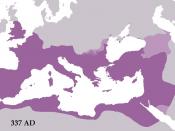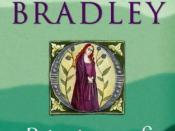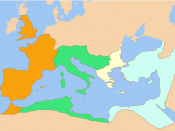Marion Zimmer Bradley in her novel, Priestess of Avalon, tells the story of a girl named Eilan and follows her for her life story. Princess Eilan is the daughter of Rian, priestess of the holy isle of Avalon, and Prince Coelius of Camulodunum in Britannia, circa 300 A.D. When her mother dies giving birth to Eilan, her father raises her in the Roman manner. Then war threatens Camulodunum, Princess Eilan is sent to Avalon to learn the ways of the priestesses of the Old Religion, the pagan beliefs that in that time period still hold sway in much of the British Isles. Hidden behind the ghostly mists of magical Avalon, Eilan grows into early womanhood as a priestess of the Old Religion. But then she becomes attracted to Constantius, a Roman officer with ambitions to greatness. Defying the orders of her aunt Ganeda, the Lady of Avalon, Eilan takes the place of another priestess and partners with Constantius in a sexual rite destined to create a Child of Prophecy.
As a result of Eilan's disobedience, Ganeda banishes her from Avalon and strips her of the power to penetrate the mist that conceals the isle. Eilan takes comfort in knowing that she will bear the child who is the hope of Britannia. She becomes a good citizen of the Roman Empire and a good wife. When she bears Constantius a son, he is named Constantine. And in time, though Eilan suffers much loss and sorrow in the journey, her son does become Constantine the Great, emperor over all Rome and all its territories. But something is wrong. The child of prophecy was supposed to lead Britannia back to its old ways, but Constantine has become convinced that the new religion of Christianity is the one true religion. Aging Eilan, the priestess of Avalon, now Flavia Helena Augusta, must decide whether she will convert as the mother of the most powerful Christian in the Roman empire, or whether she will risk her life to defy her beloved son. She never decides which religion she is devoted to, but helps both sides. She finally fakes her own death to return to Avalon, the place in which she missed in the 60 years she was away.
The major conflict in the novel is one in which Eilan is either fighting with those close to her, or with herself. Throughout the novel, she goes through many trials and tribulations, which creates a rise and fall of conflict and thus never revealing one major conflict, only the struggles in which she faces throughout her life. One of the first conflicts in the novel is when Ganeda, Eilan's aunt and Lady of Avalon casts Eilan out of Avalon, " 'Punishment?' There was venom in her smile. 'Did I not promise the Roman I would do you no harm? You have chosen your own condemnation, Helena. When Constantius leaves, you shall go with him...' ". What Ganeda did completely shattered Eilan's world, and threw her into solitude, but also made Eilan's relationship with Constanius flourish. Eilan's next crisis came when Constanius was forced to leave Eilan and marry another woman and eventually become Emperor, " 'Constantius...' I whispered, 'this is the opportunity you have dreamed of. All your life you have been preparing to be an Emperor...' 'With you at my side, Helena - not alone!' My arms tightened around him, and then, like a spear to the heart, the realization came". This crisis literally changed Eilan's life and her whole direction of life. She considered suicide, but promised Constantius that she wouldn't. The final tragedy in Eilan's life came when her son Constantine (who was Emperor at the time) sentenced his own son to death, " 'you are not Abraham - you are Theseus, and a fool!' I raged, waving the [death] mask in his face until he cowered. 'Even if he had tried [to seduce Constantine's wife], which I do not for a moment believe, what kind of sin is a failed seduction compared to the murder of your own child?! Perhaps the Christian god can forgive you - He allowed his own son to die! No pagan deity could forgive such a crime!' ". Constantine made a hasty decision, and a rift formed between Eilan and her own son that never healed, and forced her to escape the Empire and fake her own death. Throughout Eilan's life she endures a series of catastrophes, but somehow comes through a strong and secure woman, who learns from her pains, instead of lingering on them.
From reading Priestess of Avalon, the reader becomes more aware of what a person can go through throughout a life, and what a person can endure. The reader gets that older people still have their minds intact, and what they could be looking forward to when their older. The reader also gains a new perspective on religious situations, and how a person can be more tolerant and not so persecutive. The religious persecutions throughout the novel show what happened to the Christians when they were tyrannized by the pagans, and showed how the Christians turned on the pagans as soon as they got the chance. The novel just gives a new perspective on how to treat a person of a different religion, as well as what a person can withstand throughout a lifetime.
The first pages of Priestess of Avalon tell a story of their own. The Bradley estate owns the copyright, but the authorship is Diana L. Paxson's. Although well written, the novel generally has the hurried quality that can afflict work-for-hire: a story of the scope of this novel is more suited to an epic length, but Priestess of Avalon comes in at just under 500 pages. The characters rarely come fully alive. Much of the action happens in reviewing narrative, giving the book a cool, distant feel. Toward the final third of Priestess of Avalon, the conflicts between Eilan and her increasingly dictatorial son begin to be engaging, but it may be too late to draw some readers in. The novel is an intriguing example of fiction that weaves oral and historical records to produce a convincing story, but beside its predecessor, The Mists of Avalon, it feels lacking. Sadly, it's rarely a good idea for one writer to try to enliven a dead colleague's vision, no matter how vital that original vision or how strong the connection between the two writers may have been.


